Recent studies show that indoor plants can reduce stress levels by up to 40% while improving air quality by removing harmful toxins. You’ll discover how these seven carefully selected houseplants can transform your living spaces into vibrant, healthier environments without demanding excessive maintenance. From low-light survivors to stunning statement pieces, each plant offers unique benefits for your home’s aesthetic and well-being. Let’s explore how these green companions can enhance your interior design while fitting your lifestyle and skill level.
Contents
- 1 The Elegant Snake Plant: A Beginner’s Best Friend
- 2 Peace Lily: Bringing Serenity and Clean Air
- 3 Monstera Deliciosa: Statement-Making Tropical Beauty
- 4 ZZ Plant: Thriving in Low-Light Corners
- 5 Pothos: The Versatile Trailing Wonder
- 6 Spider Plant: Natural Air-Purifying Champion
- 7 Fiddle Leaf Fig: Bold and Architectural Impact
The Elegant Snake Plant: A Beginner’s Best Friend
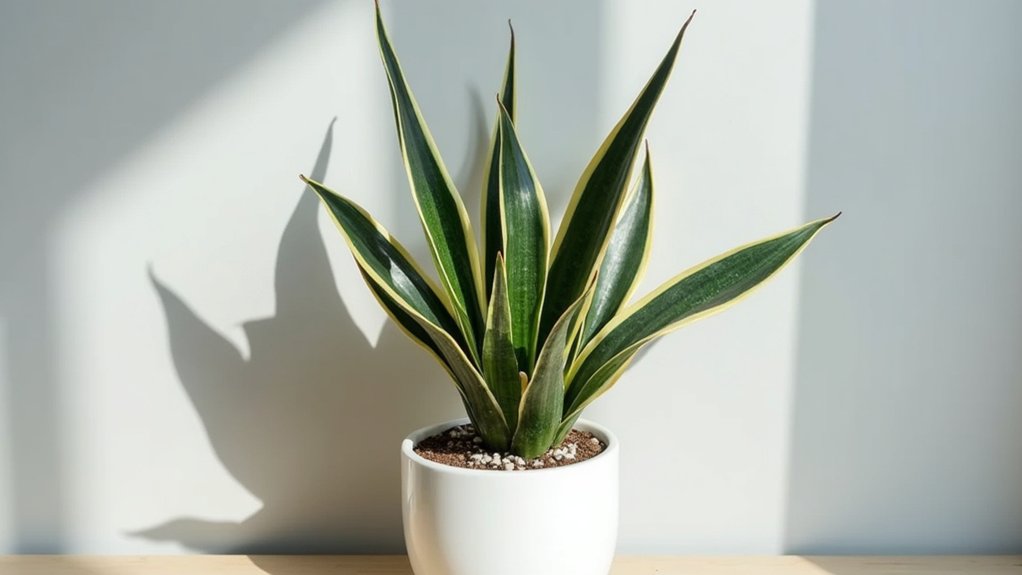
The Snake Plant (Sansevieria trifasciata) is a striking succulent characterized by its tall, rigid, sword-like leaves that grow vertically from a basal rosette. Its distinctive foliage features dark green bands and yellowy-gold edges, creating an architectural statement in any room.
This hardy plant can grow anywhere from 6 inches to several feet tall, making it adaptable to various spaces while purifying indoor air through its unique ability to convert CO2 to oxygen at night.
- Light Requirements: Tolerates low light but thrives in indirect bright light; can handle some direct sun
- Water Needs: Allow soil to dry completely between waterings; water less in winter
- Soil Type: Well-draining potting mix; preferably cactus or succulent blend
- Temperature: Comfortable in normal room temperatures (60-85°F)
- Humidity: Adapts to any humidity level
- Container: Pot with drainage holes; slightly root-bound conditions acceptable
Regular maintenance of a Snake Plant is remarkably straightforward, making it ideal for busy or forgetful plant parents.
Remove any yellowed or damaged leaves by cutting them at the base, and dust the leaves periodically with a damp cloth to maintain their glossy appearance and ensure optimal photosynthesis.
Inspect monthly for signs of root rot or pest issues, particularly in areas where leaves meet the soil.
While the plant rarely needs repotting, divide overcrowded plants every 3-4 years in spring to maintain healthy growth and propagate new specimens.
Peace Lily: Bringing Serenity and Clean Air
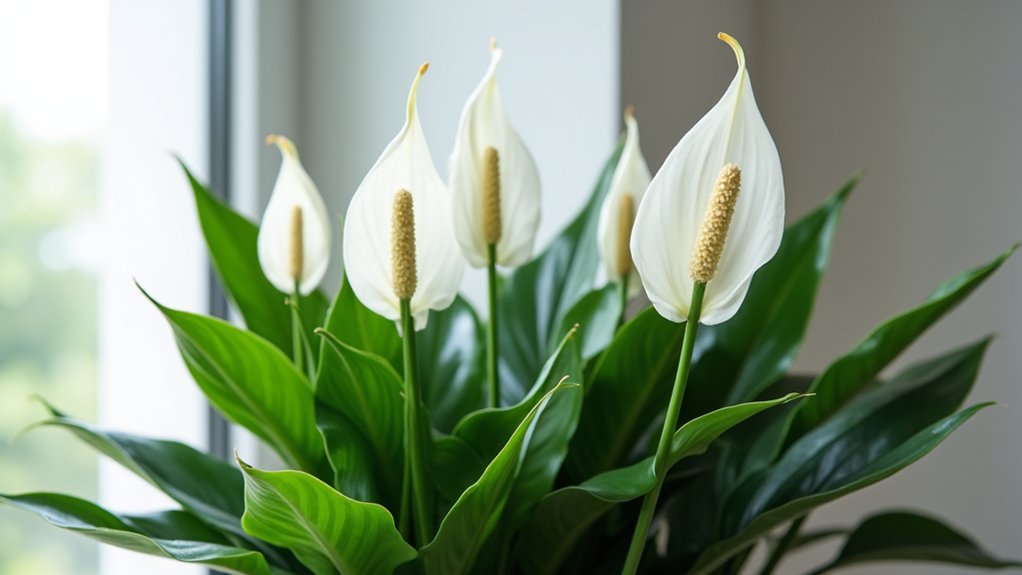
The Peace Lily (Spathiphyllum) is an elegant tropical plant known for its glossy dark green leaves and distinctive white flowers that bloom throughout the year. This popular houseplant features long, lance-shaped foliage that grows in clumps, creating a lush, fountain-like appearance.
Beyond its aesthetic appeal, the Peace Lily is recognized as one of NASA’s top air-purifying plants, effectively removing common indoor pollutants like benzene, formaldehyde, and carbon monoxide.
- Light: Thrives in medium to low indirect light; avoid direct sunlight
- Water: Keep soil consistently moist but not waterlogged; water when top inch of soil feels dry
- Humidity: Prefers high humidity levels; 50% or higher
- Temperature: Maintains best growth between 65-80°F (18-27°C)
- Soil: Well-draining potting mix rich in organic matter
- Fertilizer: Feed with balanced liquid fertilizer every 6-8 weeks during growing season
Regular grooming and monitoring are essential for maintaining a healthy Peace Lily. Remove yellowed or browning leaves at the base to promote new growth and prevent disease spread.
Dust the leaves monthly with a damp cloth to ensure optimal photosynthesis and maintain the plant’s air-purifying capabilities. Watch for signs of pests like spider mites or mealybugs, particularly in warm, dry conditions, and treat promptly with insecticidal soap if detected.
Monstera Deliciosa: Statement-Making Tropical Beauty
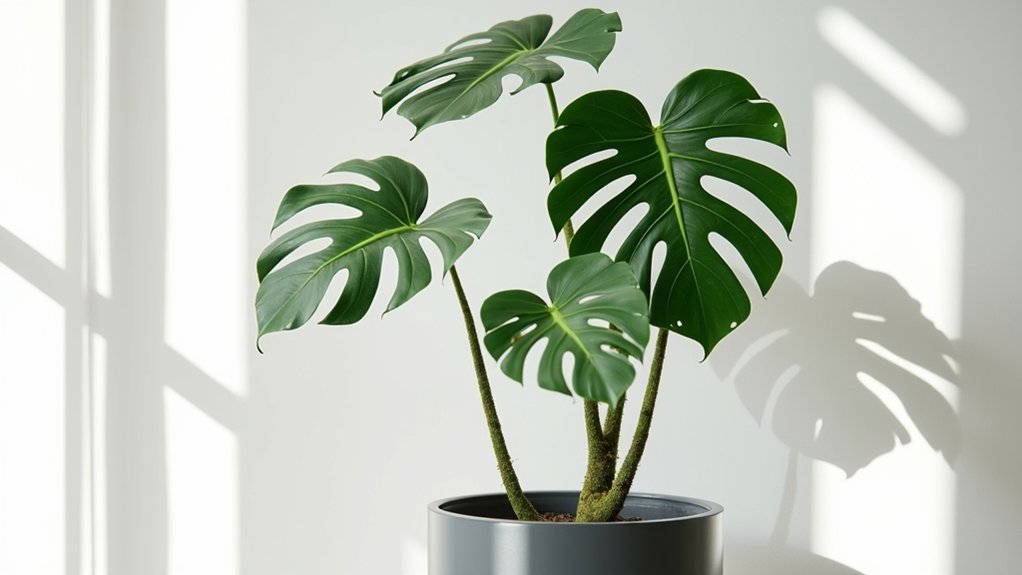
The Monstera Deliciosa, also known as the Swiss Cheese Plant, is a striking tropical specimen that commands attention in any indoor space. Its large, glossy leaves develop distinctive natural holes and splits as they mature, creating the iconic fenestrated pattern that makes this plant instantly recognizable.
Growing up to 10 feet tall indoors, this climbing vine produces heart-shaped leaves that can reach up to 3 feet in length, making it a dramatic focal point in home décor.
Growing Conditions:
- Bright, indirect light – avoid direct sunlight which can burn leaves
- Moderate to warm temperatures between 65-85°F (18-29°C)
- High humidity levels of 60% or higher
- Well-draining potting mix rich in organic matter
- Water when top 2-3 inches of soil feels dry
- Monthly fertilization during growing season (spring and summer)
Regular maintenance is essential for keeping a Monstera Deliciosa looking its best. Dust the leaves monthly with a damp cloth to maintain photosynthesis efficiency and showcase their natural shine.
Provide support through a moss pole or trellis as the plant matures, allowing it to climb naturally. Prune yellowing leaves and trim aerial roots if desired, though these roots can be guided back into the soil to strengthen the plant.
Rotate the pot quarterly to ensure even growth, and inspect regularly for common pests like spider mites and scale insects.
ZZ Plant: Thriving in Low-Light Corners

The ZZ Plant (Zamioculcas zamiifolia) is a striking tropical perennial known for its glossy, dark green leaves that grow in a distinctive arching pattern. Each stem produces multiple pairs of oval-shaped leaflets, creating a feather-like appearance that adds architectural interest to any indoor space.
This drought-tolerant plant features thick, potato-like rhizomes beneath the soil that store water, contributing to its remarkable resilience and adaptability to various indoor environments.
- Light: Tolerates low to moderate indirect light; avoid direct sunlight
- Water: Allow soil to dry between waterings; water every 2-3 weeks
- Soil: Well-draining potting mix with added perlite
- Humidity: Adapts to normal indoor humidity levels
- Temperature: Thrives in 65-75°F (18-24°C)
- Container: Pot with drainage holes to prevent root rot
- Fertilizer: Light feeding with balanced fertilizer every 3-4 months during growing season
Regular maintenance of a ZZ Plant primarily involves dust removal from its waxy leaves using a damp cloth, which helps maintain its photosynthetic efficiency and attractive appearance.
Remove any yellowing or dead leaves at the base of the plant to prevent potential fungal issues and promote new growth. While the plant is highly resistant to pests, occasional inspection of leaf undersides and stems ensures early detection of any potential problems.
Rotating the pot quarter-turn monthly encourages even growth and prevents the plant from leaning toward light sources.
Pothos: The Versatile Trailing Wonder
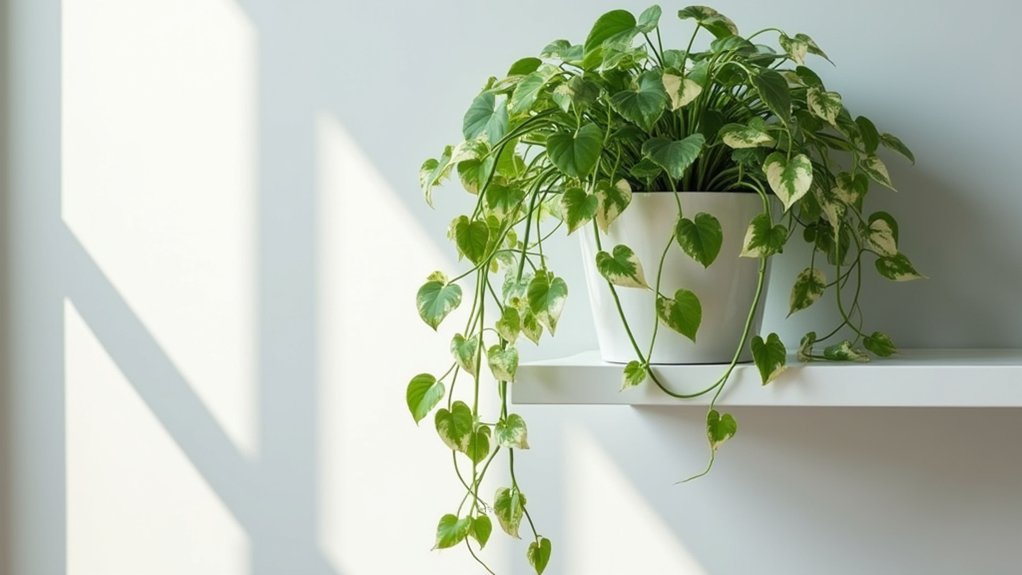
Pothos (Epipremnum aureum) is a popular trailing houseplant known for its heart-shaped leaves and adaptable nature. This versatile plant comes in several varieties, featuring variegated patterns of green, yellow, white, or marble-like combinations on its foliage. The vines can grow several feet long, making it perfect for hanging baskets, climbing poles, or cascading from high shelves, while also being excellent at purifying indoor air.
- Light: Tolerates low to bright indirect light; avoid direct sunlight
- Water: Allow top 1-2 inches of soil to dry between waterings
- Soil: Well-draining potting mix
- Temperature: 60-80°F (15-27°C)
- Humidity: Adaptable to average indoor humidity
- Fertilizer: Monthly feeding with balanced houseplant fertilizer during growing season
Regular pruning is essential to maintain the plant’s desired shape and promote fuller growth. Trim long vines just above a leaf node to encourage branching, and remove any yellowed or damaged leaves promptly.
Wiping the leaves occasionally with a damp cloth removes dust and helps the plant photosynthesize more efficiently. Inspect regularly for common pests like mealybugs or spider mites, particularly in areas where vines touch walls or other surfaces.
Spider Plant: Natural Air-Purifying Champion
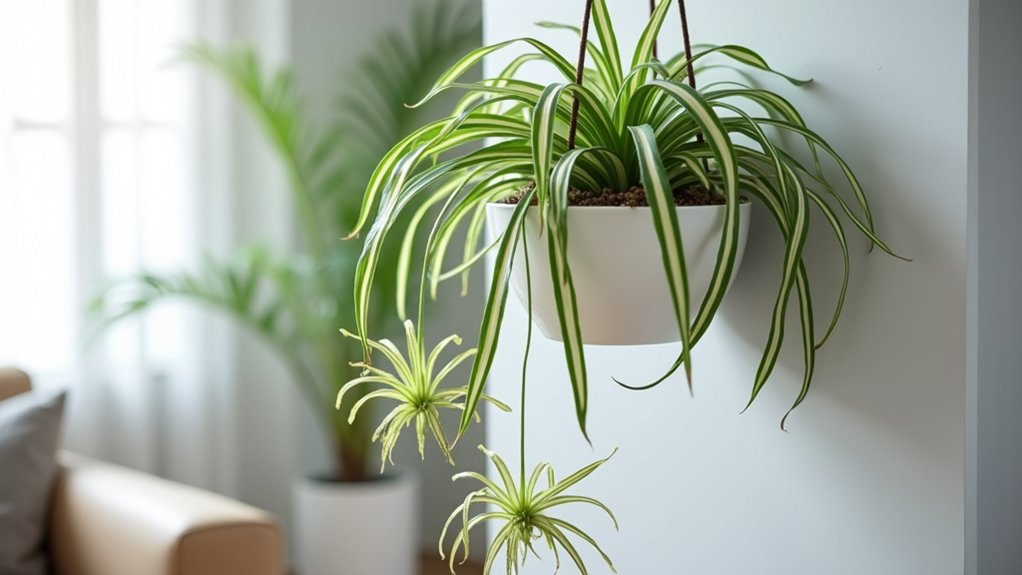
Spider Plants (Chlorophytum comosum) are graceful, arching plants known for their long, slender leaves with distinctive white or cream stripes running lengthwise.
These natural air purifiers earned their name from their spiderette offspring, which dangle from long stems like spiders on a web. As one of NASA’s top-rated air-cleaning plants, Spider Plants effectively remove common indoor pollutants like formaldehyde and xylene while adding an elegant cascade of foliage to any space.
Light: Thrives in bright, indirect light; avoid direct sunlight
Water: Keep soil moderately moist; allow top inch to dry between waterings
Temperature: Comfortable in normal room temperatures (60-75°F)
Humidity: Adapts to average indoor humidity levels
Soil: Well-draining potting mix
Fertilizer: Light feeding with balanced fertilizer during growing season
Container: Pot with drainage holes; can be hung or placed on shelves
Regular grooming keeps Spider Plants looking their best and promotes healthy growth.
Remove any yellow or brown leaves at the base, and trim damaged leaf tips with clean scissors. When spiderettes appear, either remove them to maintain the parent plant’s energy or leave them attached to propagate new plants.
Consider repotting every 2-3 years when roots become visible through drainage holes, and flush the soil occasionally to prevent salt buildup from tap water.
Fiddle Leaf Fig: Bold and Architectural Impact
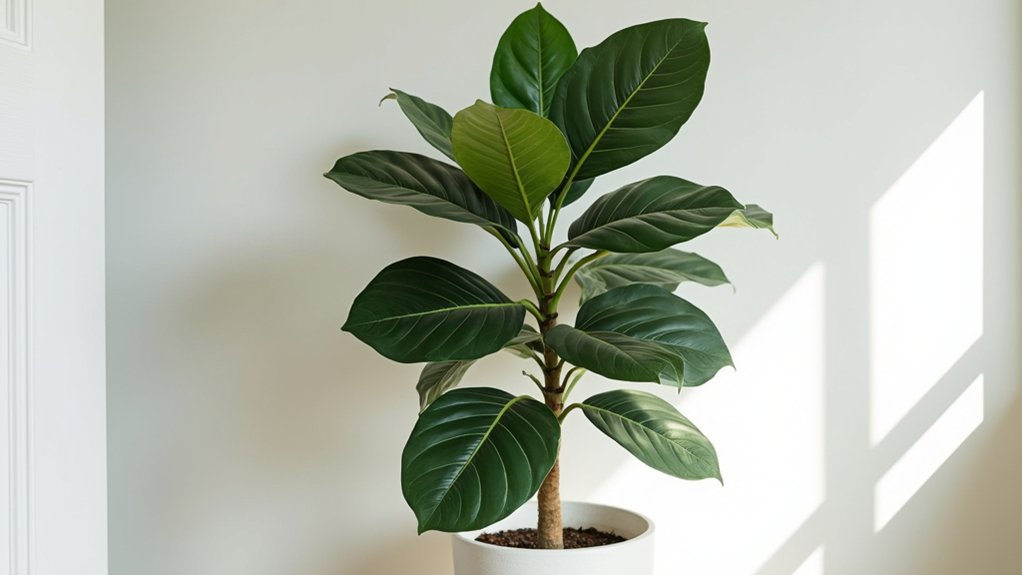
The Fiddle Leaf Fig (Ficus lyrata) is a striking indoor plant known for its large, violin-shaped leaves that create a dramatic architectural presence in any room.
Growing up to 10 feet tall indoors, this tropical plant features thick, leathery leaves with prominent veining and a glossy dark green finish. Its upright growth pattern and statement-making foliage have made it a favorite among interior designers and plant enthusiasts seeking to create bold visual impact in their spaces.
- Light: Bright, indirect sunlight; can tolerate some direct morning sun
- Water: Allow top 2 inches of soil to dry between waterings
- Humidity: Prefers 40-60% humidity
- Temperature: 60-75°F (15-24°C)
- Soil: Well-draining, rich potting mix
- Fertilizer: Feed monthly during growing season with balanced fertilizer
- Container: Large pot with adequate drainage holes
Regular cleaning of the large leaves with a damp cloth helps maintain photosynthesis efficiency and prevents dust accumulation.
Rotate the plant quarterly to ensure even growth, as it tends to grow toward light sources. Avoid moving the plant frequently, as Fiddle Leaf Figs are sensitive to environmental changes and may respond by dropping leaves.
Prune in spring to maintain desired shape and remove any damaged or yellowing leaves promptly to prevent disease spread and maintain the plant’s aesthetic appeal.
